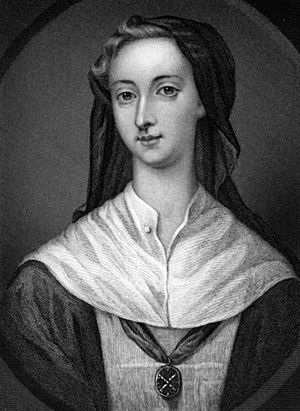Catherine Douglas, Duchess of Queensberry facts for kids
Quick facts for kids
Catherine Hyde
|
|
|---|---|
| Duchess of Queensbury | |

Catherine Douglas Portrait
|
|
| Born | 1701 |
| Died | 1777 |
| Spouse(s) | Charles Douglas, 3rd Duke of Queensberry |
| Issue | Henry Douglas, Earl of Drumlanrig Charles Douglas, Earl of Drumlanrig |
| Father | Henry Hyde, 4th Earl of Clarendon |
| Mother | Jane Leveson-Gower |
Catherine Hyde, later known as the Duchess of Queensberry, was an important English lady in London. She was born in 1701 and passed away in 1777. She was known for being a socialite, meaning she was very active in high society. She also supported artists, especially the writer John Gay.
| Top - 0-9 A B C D E F G H I J K L M N O P Q R S T U V W X Y Z |
Her Life and Family
Catherine Hyde was often called "Kitty" by her friends. She was the second daughter of Henry Hyde, 4th Earl of Clarendon, and Jane Leveson-Gower. When she was younger, she worked as a Lady of the Bedchamber for Queen Anne. This was an important role helping the Queen.
Marriage and Homes
Catherine married Charles Douglas, 3rd Duke of Queensberry, on March 10, 1720. They had two sons together. The couple lived in a few different places. Their main homes were Douglas House in Petersham, which is now part of London, and Queensberry House in Edinburgh, Scotland.
A Unique Socialite
The Duchess was famous for her beauty and her great sense of fashion. She was a very important person in London's high society. She often hosted big parties and masquerades, which were fancy dress parties.
Her Eccentric Style
People at the time thought she was quite unusual or "eccentric." For example, she never served meat at her dinner parties. Once, she even asked half of her guests to leave a party because she didn't like them!
She also dressed differently from others, even when she was older. She liked to wear clothes that were popular when she was young. She famously said she refused "to cut and curl my hair like a sheep's head." She was also known for wearing an apron, which was unusual for a duchess. A famous portrait by Charles Jervas from the 1720s shows her wearing one.
Standing Up for a Friend
In 1728, King George II banned her from his royal court. This happened because she spoke up for her friend, John Gay. Gay's play, Polly, was a satire, which means it made fun of things. The King and Queen didn't like it and refused to let it be performed. The Duchess tried to convince them, but the King was upset by her directness.
The Duchess wasn't bothered by being banned. She wrote, "The Duchess of Queensberry is surprised and well pleased that the King hath given her so agreeable a command as to stay from Court." This shows she was quite bold and independent.
Supporting Artists and Writers
The Duchess was a good friend to many writers and poets in England and Scotland. These included William Congreve, James Thompson, Alexander Pope, Matthew Prior, Allan Ramsay, and William Whitehead. Many of these friends wrote about her in their poems and other works. Allan Ramsay, for example, wrote a poem about her leaving Scotland in 1734.
She was also said to have influenced William Pitt, 1st Earl of Chatham, who was a very important politician and Prime Minister.
Julius Soubise
In 1764, a young man named Julius Soubise came to live with the Duchess. He was an Afro-Caribbean slave who was given to her by a relative. The Duchess freed him and renamed him after a French duke.
A Privileged Life
The Duchess treated Soubise like her own son, and her husband, the Duke, agreed. Soubise became the Duchess's riding and fencing teacher. He became very popular among young noblemen and joined many fashionable clubs. He sometimes called himself "Prince Ana-Ana-maboe" or "The Black Prince," claiming to be African royalty.
A Famous Print
A well-known satirical print, or cartoon, by William Austin shows the Duchess and Soubise. It was published in 1773 and shows them having a fencing match. This print helped make Soubise even more famous in London society.
Images for kids


